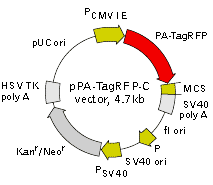
|
||||||||||
|
||||||||||

|
|
||||||||||||||||||||||||||||||||||||||||||||||||||||||||||||||||||||||||||||||||||||||||||||||||||||||||||||||||||||||||||||||||||||||||||||||||||||||||||||||||||||||
The vector sequence has been compiled using the information from sequence databases, published literature, and other sources, together with partial sequences obtained by Evrogen. This vector has not been completely sequenced. |
|||||||||||||||||||||||||||||||||||||||||||||||||
 Download
|
| ||||||||||||||||||||||||||||||||||||||||||||||||
| PA-TagRFP | BspE I | Xho I | Hind III | Pst I | Kpn I | Apa I | BamH I | Stops | |||||||||||||||||||||||||||||
| Bgl II | Sac I | EcoR I | Sal I* | Sac II | Sma I/Xma I | Xba I# | Bcl I# | ||||||||||||||||||||||||||||||
| ... | TCC.GGA | .CTC | . | AGA.T | CT | .C | GA.G | CT.C | AA.GCT.T | C | G.AAT.T | C | T.GCA. | G | TC.GAC | . | GGT.A | CC | .GC | G.G | G | C.CC | G. | GG | A.TCC | .ACC.GGA | . | TC | T.AG | A | . | TAA | .C | TG.A | TC.A | ... | |
# – sites are blocked by dam methylation. If you wish to digest the vector with these enzymes, you will need to transform the vector into a dam- host and make fresh DNA.
* – not unique site.
Vector description
pPA-TagRFP-C is a mammalian expression vector encoding photoactivatable red fluorescent protein
Note: The pPA-TagRFP-C vector encodes the
The vector backbone contains immediate early promoter of cytomegalovirus (PCMV IE) for protein expression, SV40 origin for replication in mammalian cells expressing SV40 T-antigen, pUC origin of replication for propagation in
SV40 early promoter (PSV40) provides neomycin resistance gene (Neor) expression to select stably transfected eukaryotic cells using G418. Bacterial promoter (P) provides kanamycin resistance gene expression (Kanr) in
Generation of
A localization signal or a gene of interest can be cloned into MCS of the vector. It will be expressed as a fusion to the
Note: The plasmid DNA was isolated from dam+-methylated
Expression in mammalian cells
pPA-TagRFP-C vector can be transfected into mammalian cells by any known transfection method. CMV promoter provides strong, constitutive expression of
Propagation in
Suitable host strains for propagation in
Location of features
PCMV IE: 1-589
Enhancer region: 59-465
TATA box: 554-560
Transcription start point: 583
Kozak consensus translation initiation site: 600-610
Start codon (ATG): 607-609
Stop codon: 1402-1404
Last amino acid in
MCS: 1324-1401
SV40 early mRNA polyadenylation signal
Polyadenylation signals: 1544-1549 & 1573-1578
mRNA 3' ends: 1582 & 1594
f1 single-strand DNA origin: 1641-2096
Bacterial promoter for expression of Kanr gene
-35 region: 2158-2163
-10 region: 2181-2186
Transcription start point: 2193
SV40 origin of replication: 2437-2572
SV40 early promoter
Enhancer (72-bp tandem repeats): 2270-2341 & 2342-2413
21-bp repeats: 2417-2437, 2438-2458 & 2460-2480
Early promoter element: 2493-2499
Major transcription start points: 2489, 2527, 2533 & 2538
Kanamycin/neomycin resistance gene
Neomycin phosphotransferase coding sequences:
Start codon (ATG): 2621-2623
Stop codon: 3413-3415
G->A mutation to remove Pst I site: 2803
C->A (Arg to Ser) mutation to remove BssH II site: 3149
Herpes simplex virus (HSV) thymidine kinase (TK) polyadenylation signal
Polyadenylation signals: 3651-3656 & 3664-3669
pUC plasmid replication origin: 4000-4643
References:
- Gorman C. High efficiency gene transfer into mammalian cells. In DNA cloning: A Practical Approach, Vol. II. Ed. D. M. Glover. (IRL Press, Oxford, U.K.). 1985; 143-90.
- Haas J, Park EC, Seed B. Codon usage limitation in the expression of HIV-1 envelope glycoprotein. Curr Biol. 1996; 6 (3):315-24. / pmid: 8805248
- Kozak M. An analysis of 5'-noncoding sequences from 699 vertebrate messenger RNAs. Nucleic Acids Res. 1987; 15 (20):8125-48. / pmid: 3313277
- Subach FV, Patterson GH, Renz M, Lippincott-Schwartz J, Verkhusha VV. Bright monomeric photoactivatable red fluorescent protein for two-color super-resolution sptPALM of live cells. J Am Chem Soc. 2010; 132 (18):6481-91. doi: 10.1021/ja100906g / pmid: 20394363
Notice to Purchaser:
PA-TagRFP-related materials (also referred to as "Products") are intended for research use only. The Products are covered by European Pat. 1994149 and other Evrogen Patents and/or Patent applications pending. By use of these Products, you accept the terms and conditions of the applicable Limited Use Label License.
|
Copyright 2002-2023 Evrogen. All rights reserved. Evrogen JSC, 16/10 Miklukho-Maklaya str., Moscow, Russia, Tel +7(495)988-4084, Fax +7(495)988-4085, e-mail:evrogen@evrogen.com |


